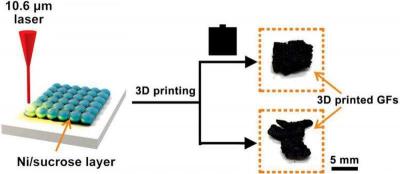Researchers at Rice University and China's Tianjin University have used 3D laser printing to fabricate centimeter-sized graphene objects. The team has demonstrated the making of graphene foams from non-graphene starting materials, in a method that could reportedly be scaled for additive manufacturing applications with pore-size control. The process is conducted at room temperature, without the need for molds. The rather unusual starting materials are powdered sugar and nickel powder.

3D laser printers work differently than the more familiar extrusion-based 3D printers, which create objects by squeezing melted plastic through a needle as they trace out two-dimensional patterns. In 3D laser sintering, a laser shines down onto a flat bed of powder. Wherever the laser touches powder, it melts or sinters the powder into a solid form. The laser is rastered, or moved back and forth, line by line to create a single two-dimensional slice of a larger object. Then a new layer of powder is laid over the top of that layer and the process is repeated to build up three-dimensional objects from successive two-dimensional layers.
The new Rice process used a commercially available CO2 laser. When this laser was directed at the sugar and nickel powder, the sugar was melted and the nickel acted as a catalyst. Graphene formed as the mixture cooled after the laser had moved on to melt sugar in the next spot, and the team conducted a study to find the optimal amount of time and laser power to maximize graphene production.
The foam created by the process is a low-density, 3D form of graphene with large pores that account for more than 99% of its volume.
"This simple and efficient method does away with the need for both cold-press molds and high-temperature CVD treatment," said co-lead author Junwei Sha, a former student in Tour's lab who is now a postdoctoral researcher at Tianjin. "We should also be able to use this process to produce specific types of graphene foam like 3D printed rebar graphene as well as both nitrogen- and sulfur-doped graphene foam by changing the precursor powders."